|
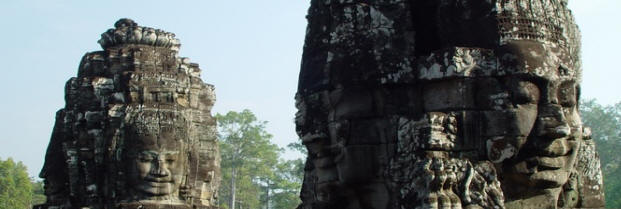 |
|
(Picture above:
face-towers of Bayon Temple in Angkor Thom) |
|
Glossary of Religion and Arts
---
|
|
Airavata |
The elephant on
which Indra rides
(usually
three-headed, and sometimes one-headed; also called
Erawan) |
%20riding%20his%203-headed%20elephant%20Airavata.jpg)
from Banteay Srei |
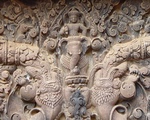
from
Banteay Srei |
|
apsaras |
A
celestial dancer who delights the inhabitants of paradise. |
.jpg)
from Angkor Wat |
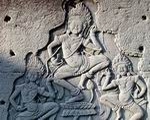
from Bayon |
|
asura
(rakshasa) |
Demon, and enemy of gods. |
.jpg)
from Angkor Wat |
.jpg)
from Angkor Thom |
|
Brahma |
Hindu creator god with four directional faces
and four hands. |

from Sofitel
Hotel |
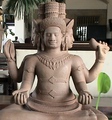
from an Angkor hotel |
|
Churning of the Sea of Milk |
A Hindu myth in which gods & demons
cooperate to churn the ocean, in order to produce immortality. The
body of a long naga (a serpent) is used as the rope.
|
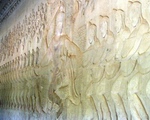
from Angkor Wat |
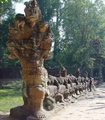
from Preah Khan |
|
devata |
Female deity. |
%20(from%20Banteay%20Srei).jpg)
from Angkor Wat |
%20(from%20Ta%20Som).jpg)
from Preah Khan |
|
dvarapala |
A human-shaped god or
warrior which guards the entrances to temples. |
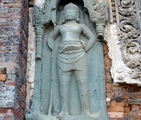
from Prea Ko |

from Thommanon |
|
face tower |
A tower with
four faces which probabily
represent Jayavarman VII as
Bodhisattva of Compassion or some other deity. |

from Angkor Thom |
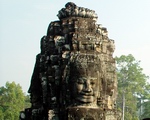
from Bayon |
|
Ganesha |
An elephant-headed
son of Shiva. According to legend, Shiva cut
his son's head in anger and in
remorse replaced it with the first that came to hand, the head of an elephant,
Airavata, of Indra. |

from Banteay Srei |
|
Garuda |
A bird-man which is Vishnu's steed
and is the enemy of snakes, often seen to grasp them in his claws. |
%20seen%20on%20a%20wall.jpg)
from Preah Khan |
.jpg)
from Cambodian
Cultural Village |
|
Hanuman |
In Hinduism,
Hanuman is a monkey-man who aided Rama (an avatar of Vishnu) in rescuing his
wife, Sita, from Ravana, the king of
rakshasa (i. e., asuras) ruling the
land of Lanka. |
.jpg)
from Angkor Wat |

from Banteay Srei |
|
Hayagriva |
Vishnu in the form
of a horse. |

from Banteay Srei |
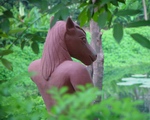
from Sofitel
Hotel |
|
Indra |
The King of the Gods
in early Hinduism with the elephant mount
Airavata, subordinate to Vishnu and Shiva In Buddhism, Indra and Brahma accompany Buddha.
|
(from%20a%20lintel%20in%20Banteay%20Srei).jpg)
from Banteay Srei |
(taken%20by%20Meimei).jpg)
from Lolei |
|
Krishna |
One of the avatars,
or incarnations of Vishnu, and hero of an epic.
|
%20on%20Garuda%20seen%20at%20Angkor%20Airport%20(a%20replica%20of%20a%20relief%20seen%20in%20Angkor%20Wat%20which%20we%20missed).jpg)
from Angkor
Airport |
|
libraries |
Auxiliary temple buildings in pairs
in front of the temple platform, formerly thought to contain
copies of scriptures. |
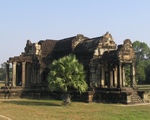
from Angkor Wat |
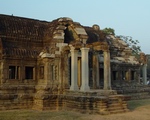
from Angkor Wat |
|
linga |
Linga, a stylised
phallus, is used as a symbol for the worship of Hindu God
Shiva. |
%20representing%20the%20essence%20of%20God%20Shiva.jpg)
from Preah Khan |
|
makara |
A
sea-monster, like a sea-snake with crocodile head and an elephant's trunk. It is
a decoration on many structures. |
%20(from%20banteay%20Srei).jpg)
from Banteay Srei |
.jpg)
from Banteay Srei |
|
Mucalinda |
A multi-headed naga that sheltered Buddha
under his hood during a rainstorm. |
.jpg)
from East Mebon |
|
naga |
A snake or dragon,
often multi-headed,
appears on temple causeways ("naga
bridges") as a bridge between the earthly and celestial worlds;
also involved in Churning of Sea of Milk. |
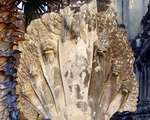
from Angkor Wat |
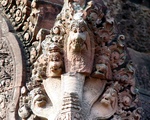
from Banteay Srei |
|
Narasimha |
Fourth avatar of
Vishnu, Narasimha is a lion-man which killed Hiranyakashipu in a
legend. |
.jpg)
from Banteay Srei |
.jpg)
from Banteay Srei |
|
Nandi |
A bull, Shiva's vehicle, whose sculptures are included in the
courtyards of most Shiva temples. |
.jpg)
from Preah Ko |
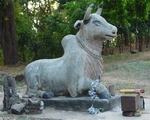
from Phnom
Bakheng |
|
Ramayana |
Also called Ramker,
Ramayana is a Hindu epic which
tells the story of Rama (an avatar of Vishnu) to recover his
wife Sita with assistance from Hanuman. |
.jpg)
from Cambodian
Cultural Village |
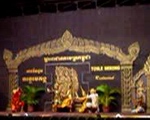
from Tonle Mekong
Restaurant |
|
Ravana |
A multi-headed &
-armed demon ruling Lank in the epic of Ramayana. |
.jpg)
from Banteay Srei |
(a%20replica%20of%20Angkor%20Wat%20relief).jpg)
from Sofitel
Hotel |
|
Shiva |
One of Hindu Great
Gods, symbol of the creative and destructive power of nature,
riding the bull Nandi. The central image in Shiva temples is the
linga. |
.jpg)
from Banteay Srei |
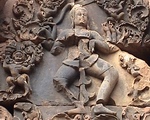
from Banteay Srei |
|
Vishnu |
One of Hindu Great
Gods, who upholds cosmic law and righteousness through many
incarnations. His best-known avatars are Rama, the hero-king of
the Ramayana, and Krishna. He rides Garuda. |
.jpg)
from Angkor Wat |
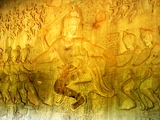
from Angkor Wat |
|
Yama |
The Lord of the dead
and directional guardian of the South, multi-armed and holding
clubs. His steed is the buffalo. |
%20riding%20a%20buffalo.jpg)
from Angkor Wat |
.jpg)
from Sofitel Hotel |